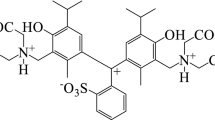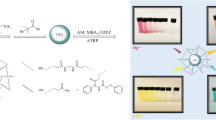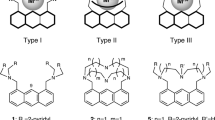Abstract
MANY metals form coloured complexes with dithizone, and the successful use of this reagent for estimating one of them in a mixture demands a careful selection of organic solvent, a rigorous control of pH and other variables such as duration of shaking, nature and amount of neutral salts present, the concentration of excess dithizone, and the concentration of ‘masking' reagents capable of competitive complex formation with interfering metals1. The coloured metal complexes (yellow, red, violet, etc.) modify the colour of the green solution containing excess dithizone giving a ‘mixed-colour' extract, and by absorptiometric measurements the proportion of metal complex can be estimated with reference to calibration curves obtained by treating known amounts of metal by the standardized procedure. Such curves are commonly valid only for one initial concentration of dithizone, and error may be introduced in view of the well-known impermanence of this reagent. The theoretically obvious solution for such systems with two coloured components is to measure the transmittency at two appropriate wave-lengths ; but this involves a burdensome amount of preliminary work for, in effect, a family of calibration curves must be constructed to cover all possible variations in reagent concentration and in the amount of metal taken for analysis2.
This is a preview of subscription content, access via your institution
Access options
Subscribe to this journal
Receive 51 print issues and online access
$199.00 per year
only $3.90 per issue
Buy this article
- Purchase on Springer Link
- Instant access to full article PDF
Prices may be subject to local taxes which are calculated during checkout
Similar content being viewed by others
References
Sandell, E. B., "Colorimetric Determination of Traces of Metals" (Interscience Publishers, New York, 1944).
Kozelka, F. L., and Kluchesky, E. F., Ind. Eng. Chem., Anal. Ed., 13, 484 (1941).
Irving, H., Andrew, G.,and Risdon, E. J.,J. Chem. Soc. (in the press).
Milton, R. V., and Hoskins, J. L., Analyst, 72, 6 (1947). Barnes H. ibid., 71, 578 (1946).
Irving, H., and Andrew, G., J. Chem. Soc. (in the press).
Author information
Authors and Affiliations
Rights and permissions
About this article
Cite this article
IRVING, H., ANDREW, G. & RISDON, E. Reversion : a New Procedure in Absorptiometry. Nature 161, 805–806 (1948). https://doi.org/10.1038/161805a0
Issue Date:
DOI: https://doi.org/10.1038/161805a0
This article is cited by
Comments
By submitting a comment you agree to abide by our Terms and Community Guidelines. If you find something abusive or that does not comply with our terms or guidelines please flag it as inappropriate.



